
42 minute read
Introduction
t was in the very early days of my devotional life that i first read this verse in
His being the supreme power. i beg to offer my respectful obeisances unto Him.”1 vice can purify members of even the most sinful races. When i first read this verse i was particularly struck by ¼r¦la Prabhup§da’s translation of the word “H¡£a”: “The area of East Germany and part of Russia is of hill tribe is known as the H¡£as.” Hungary — especially before the area. Were the H¡£as mentioned by the son of Vy§sa so many millennia
Advertisement
27
Nava-vraja-mahim§
throughout history had delivered members of the races ¼ukadeva travel the globe and save fallen souls suffering in all walks of life. To ¼r¦la Prabhup§da’s unmatched service to k¥¢£a. They also seemed to predict the eventual deliverance of the Hungarian people.
Perhaps it was because i meditated on this verse too often and too deeply that — without my soliciting the service — iskCOn’s governing body eventually requested me to take responsibility for spreading
The first phases of iskCOn’s mission in Hungary were to translate and
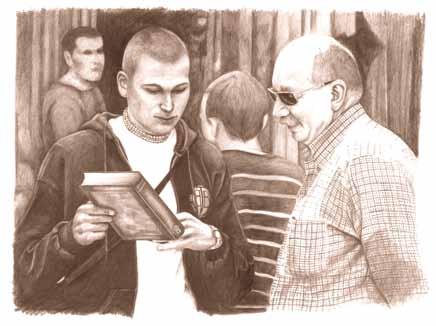

28
Introduction
was then that i began to contemplate establishing a farm community. which tees where the problems of life could be solved from cradle to grave. My mind was often preoccupied with thoughts of such a community.
Then one night i had a vivid dream. i was playing with Lord Balar§ma in a beautiful pastoral setting. After some time the Lord up and placed His lotus feet on the floor. i lay prostrate before the translate and distribute books. Everything else will follow.” As i stared in wonder at the incomparable beauty of the Supreme Personality k¥¢£a’s words are always true. After two years of searching — once the success of book distribution in Hungary had begun to soar — we finally located the property that would eventually become New Vraja-dh§ma. And just after the translation of ¼r¦la Prabhup§da’s place on the altar there. ¼r¦la Prabhup§da had given us a template results would surely come.

he area that surrounds k¥¢£a Valley — another name for New Vraja-dh§ma — has long held political and religious significance to Hungary. During the construction of one of the houses on our property a worker found a copper
29
Nava-vraja-mahim§
earlier time.2 The village of Somogyvámos — within which k¥¢£a almost completely wiped out by the Turkish invasion of 1526. They then went through different stages of prosperity and decline until end of the Soviet era.
By the time Gaura ¼akti D§sa arrived in Somogyvámos in search out.3 So when he approached the local mayor to help us purchase comprises New Vraja-dh§ma had to be purchased in many inconveniently small plots originally totalling one hundred and fifteen hectares.4 The first contingent of devotees lived in Somogyvámos the barn. Our first attempts at gardening and agriculture entertained fathers before them. As we became more adept at working the land won over the full support and friendship of the villagers. i have no doubt it was k¥¢£a’s arrangement that Laci bácsi — “Uncle Larry” as we called him — was the mayor of Somogyvámos when we k¥¢£a Valley — particularly its growing popularity as a tourist attraction — as a breath of new life in his dying village. With his encouragement we worked hard. By the time construction of the temple and

30
Introduction
employer of local labour.
Originally we began to develop k¥¢£a Valley to give shelter to the ent to me that it would be equally important to establish a model the presiding Deities of New Vraja-dh§ma. the eyes of ordinary persons in much the same way that k¥¢£a was personally present in Bhauma V¥nd§vana five thousand years ago. as He can in His original transcendental personality.”5 He revelled in the transcendental beauty of Goloka come to earth. R§dh§ — deserve His own Goloka in k¥¢£a Valley? certainly He did! features of the natural world have long been used to inspire awe and veneration to the Supreme Lord in the hearts of common men and fully devoted souls alike. Why should New Vraja-dh§ma not follow this hallowed tradition?
Since the moment i first saw R§dh§ and ¼y§masundara in a deity 6 But what most captured my heart then was Their willingness to favour Their devotees by accepting service in a far away land and residing “replicas” of V¥nd§vana all over the world.7 tomed to the pleasures of Goloka — in a padded wooden crate for Their journey to London by freight.8 Perhaps the same love with which ¼r¦la Prabhup§da had so kindly brought Their Lordships to

31
Nava-vraja-mahim§
earth to engage us in Their service would transform that crate into an opulent Vaiku£±ha airplane (vim§na i prayed that it would. Upon their arrival in England i unpacked R§dh§ and ¼y§ma and placed they waited patiently for two years. it was a special time for me. i raise funds for temple construction and to encourage devotees in their services by describing to them R§dh§ and ¼y§ma. Those descriptions community. They gave the devotees a common goal for which they accepting all austerities for the pleasure of R§dh§ and ¼y§masundara.
Devotee labourers rammed the temple’s earthen walls in the devotees kept up a year-round marathon to pay for it all.9 children waded through waist-high snow to Whenever i would wonder whether They were taking note of all these things. no roads — nothing but a dream? Did They smile to see devotee k¥¢£a’s altar will be”? Were they pleased with the brick altar upon some hired workers and guests daily offered flowers? it is my conviction that They did observe these things and that 10

32
Introduction
R§dh§’s and ¼y§masundara’s arrival in k¥¢£a Valley was one of the most memorable days in the history of the Hungarian Every last devotee and sympathiser in the country attended the festival. As Their Lordships stood on a platform before Their temple teary-eyed devotees offered flowers to the Lord whom they had been and by so doing He confirmed that this plot of land we had secured for Him was indeed V¥nd§vana. Simply by Their presence R§dh§ and ¼y§masundara were proclaiming the glories of V¥nd§vana just as Lord Brahm§ describes:
“The Lord is the reservoir of all pleasure. His auspicious presence is glancing touch the core of the heart. The Lord’s beautiful bodily of all heavenly planets. Thus it appeared that the Lord was personally spreading the beauty and good fortune of the spiritual world.”11

sion — the formal installation of the Deities. Up until that time the devotees just called Them “R§dh§” and “k¥¢£a.” But at the conclusion of the installation ceremony i pro to those names echo back to me from the mouths of the devotees. R§dh§-¼y§masundara’s installation was further confirmation of the
33
Nava-vraja-mahim§
presence of the dh§ma, transcendental principles.”12 in the years that followed the installation ceremony i enjoyed many intimate moments with R§dh§ and ¼y§ma during while increased my desire to make Their home more closely resemble the spiritual world. caitanya Mah§prabhu ordered His disciples to develop the lost pastime places of V¥nd§vana for the spiritual benefit of everyone.13 it was ¼r¦la Prabhup§da’s desire that places of pilgrimage be established for his disciples in the West. And now the devotees of k¥¢£a Valley wanted to develop the landscape of New Vraja-dh§ma. They were already working hard at cultivating the V¥nd§vana mood. Like devotees were keeping the k¥¢£a Valley iron constantly within the divine fire of Goloka 14
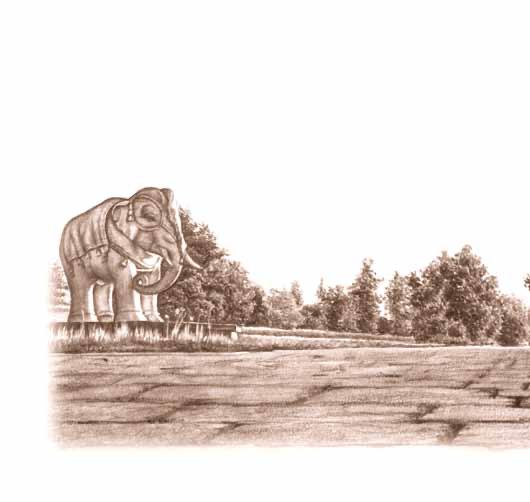

34
Introduction
For the residents of New Vraja-dh§ma it was only natural to have faith that the Lord and His abode were appearing in k¥¢£a Valley. But you to have the same faith. Surely the Lord’s abode is present in that dusty tract of land on the indian subcontinent where He actually in is considered by that scripture to be home to one of many insignificant categories of “sinful races”? How could it be so? How could such a thing even be possible?
The philosophical truths that underpin the transcendental workings of the dh§ma 15 of that deep tattva, dh§ma begins with understanding the absolute nature of the Supreme Absolute.
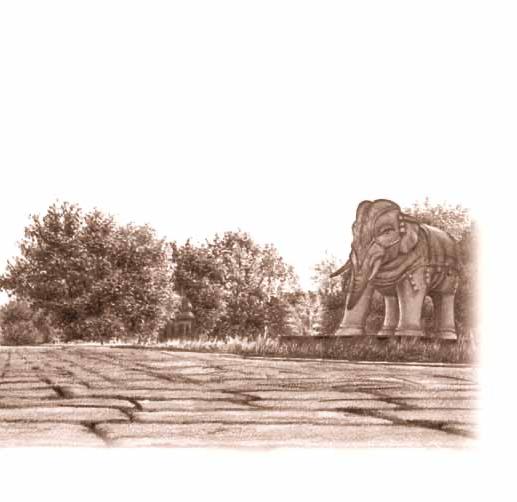
35

Nava-vraja-mahim§
Even as neophyte devotees we hear and readily accept that k¥¢£a abode goes with Him. And because the Lord is also not different from His Deity form — which is to say that the Deity is the Lord Himself — wherever the Deity of the Lord is worshipped with faith dh§ma is present as well. it is said that “k¥¢£a never leaves V¥nd§vana” ( 16 and cows in tow?
The dh§ma is the dh§ma, tells us that ¼r¦ R§dh§ refused to leave Goloka for k¥¢£a’s earthly pastimes if Vraja did not go there first to pave the way for Her arrival. We should note with interest that in deliver Hill and the Yamun§ River.17 When R§dh§ and k¥¢£a come to this R§dh§ ever without k¥¢£a.18 dh§ma are thus and wherever k¥¢£a’s pastimes dictate. dh§ma manifests in different degrees and dh§ma’s other manifestations of the dh§ma, is known as Goloka. Situated in the spiritual sky as the topmost planet and the whorl of a lotus whose

36
Introduction
V¥nd§vana. it has two features. During k¥¢£a’s pastimes it is known as the (the dh§ma form is the visible manifestation of the original the dh§ma eternally visible in the k¥¢£a’s manifest pastimes. Although apparently smaller than its potencies of the Lord. is then hidden beneath a veil of matter so that its presence is no longer - 19 one — even if unable to see features of the through its material covering — is able to feel some effects of the spiritual potency of the dh§ma through the layer of intervening matter. The degree to which a person can feel the presence of the in much the same way as k¥¢£a’s presence is directly perceived in His Deity form in proportion to one’s level of spiritual advance physical place through which we perceive the influence of k¥¢£a’s transcendental abode as the in this book i will use the term when referring to this last feature of
These three features of the dh§ma are commonly known and dh§ma has two additional manifesta the one established through the influence of such a devotee in some
The Lord as the Supersoul is situated within the heart of every

37
Nava-vraja-mahim§
living thing. Great yog¦s who desire to see the Lord meditate on ¼r¦la Prabhup§da tells us that “those who are attached to the ¼y§masundara form of k¥¢£a in love and devotion can see Him always within the heart.”20 ¼y§masundara personally resides within 21 is always there.
Because the pure devotee carries Lord k¥¢£a and the Lord’s transferred to wherever he stays. As Yudhi¢±hira Mah§r§ja says of personified. Because you carry the Personality of Godhead within 22 The pure devotee is not unlike a philosophers’ stone: because he carries k¥¢£a age — the dh§ma itself.

hile these dh§mas are as many as the devotees who both epitomised Vraja and served as prototypes for places like New Vraja-dh§ma: R¡pa Gosv§m¦’s and San§tana Gosv§m¦’s
38
Introduction
two brothers constructed a temple and installed R§dh§–Madanamohana. They also built a residence for themselves near the Deities. ¼r¦la Prabhup§da confirms that the area of R¡pa’s and San§tana’s temple and residence is a used to refer to epitomes of the dh§ma outside Bhauma V¥nd§vana.23 once sat. The Gosv§m¦s added beautiful gardens and groves around a sinful tyrant. Their constant study of certainly resonate with Orissa. in the midst of the beautiful forest surrounding the or a place form in commemoration of k¥¢£a’s According to the the village of Gop¦vallabhapura was also acknowledged as a even during the §c§rya’s time.24 it continues to be revered as a place of k¥¢£a’s pastimes today. V¥nd§vana. by many Vai¢£avas as a holy place of pilgrimage.”25 A brief history to the fact that many of the most important Deities of Vraja were

39
Nava-vraja-mahim§
a beautiful temple for Govindaj¦ at its centre. it is said that fifty 26 Visitors who go there even now can see that it remains so today.
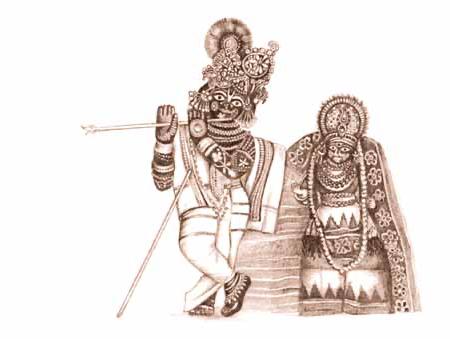

40
Introduction
V¥nd§vana established a great distance the models upon which New Vraja-dh§ma is based. town once ruled by thieves that was transformed into the epitome of Vraja by king V¦rahamv¦ra and his successors.27 Devotees are V¦rahamv¦ra’s hired dacoits stole the books as the devotees slept. and in the process to convert king V¦rahamv¦ra and his entire court into pure Vai¢£avas. fore not different from the The §c§rya’s presence inspired continual and discussion on which quickly transformed the atmosphere of Vi¢£upura. The residents of Vi¢£upura were well aware that ¼r¦niv§sa was the source of their good been glorified by your presence. Without you it will again become a forest.”28 again returned to make his residence there and guide the king and his subjects in developing and maintaining the divine sanctity of the kingdom. By the same spiritual potency that had turned a thief into
The essential element in establishing the dh§ma is k¥¢£a consciousness. V¦rahamv¦ra used his royal power: his citizens were legally bound to chant ¼r¦niv§sa was made the state Through devotional practices

41
Nava-vraja-mahim§
it was this widespread k¥¢£a consciousness that invoked the Lord’s potency.
The people of Vi¢£upura had not only an §c§rya in ¼r¦niv§sa but also a presiding Deity in Madana-mohana. The Lord’s appearance as a Deity in Vi¢£upura is said to have been no less spectacular than the V¦rahamv¦ra used a fishing net to retrieve from the nearby D§modara offset the cost of the Lord’s maintenance. The nature of Madanamohana’s appearance certainly reinforces the idea that Vi¢£upura is the epitome of V¥nd§vana. who was regularly worshipped by pure Vai¢£ava . By his Royal patronage and public support both ensured that Madana memorating the events of k¥¢£a’s life and constant both nurtured Vi¢£upura’s V¥nd§vana atmosphere.
The oral tradition of Vi¢£upura tells us that Madana-mohana often responded to the affection of His devotees by directly interced gathered around the temple for marauders took advantage of the situation to besiege Vi¢£upura. Madana-mohana rode on a horse to the ramparts of the fort and there personally manned the cannons in a successful effort to disperse the light artillery of the invaders. Evidence of the Deity’s glorious deed was found in burn marks on His clothes and the smell of gunpowder on His body.
Pastimes like this one reminded Vi¢£upura’s residents of the many ways in which k¥¢£a had long ago protected the Vraja-v§s¦s

42
Introduction
ceived of their city as V¥nd§vana. Even today the evening §rati to Madana-mohana concludes with a song that reaffirms how for its mohana resides in Vi¢£upura.”29 legacy. A visit to Vraja inspired king V¦rahamv¦ra to make his kingdom a centre of spiritual culture in the tradition of V¥nd§vana. Vi¢£upura famous for its especially in ¼r¦niv§sa’s own Manoharasahi style. in glorification of the Deities of Vi¢£upura were also composed by the successive generations of the
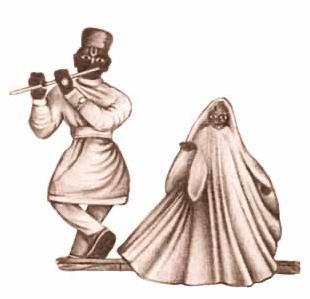

43
Nava-vraja-mahim§
Gop§la Singh also printed numerous copies of reinforcing the identity of Vi¢£upura as a centre for the the kings of Vi¢£upura sponsored and encouraged the glorification of k¥¢£a and thus the dissemination of k¥¢£a consciousness through and the distribution of transcendental literature. king V¦rahamv¦ra and his succession of Vai¢£ava rulers imported variety of fruit- and flower-bearing trees indigenous to the V¥nd§vana abode. in this way they went about transforming the topography of Vi¢£upura into that of a greater likeness of V¥nd§vana to invoke the presence of the This aspect of Vi¢£upura’s Vi¢£upura’s residents that their city was indeed divine. They saw Madana-mohana not merely as a Deity to be worshipped within the sylvan surroundings they had made to be so reminiscent of Vraja. meant to serve Madana-mohana.
The process of consecrating Vi¢£upura also included renaming people of Vi¢£upura were able to invoke the spiritual presence of ¼r¦ V¥nd§vana-dh§ma. the very palace compound that served as home to Madana-mohana. and on its outskirts. These lakes were also named after the of

44
Introduction
transformed into rose petals.30 Hemalat§ playing with k¥¢£a in the same lake.
But renaming villages or digging ponds does not consecrate them dh§ma by wherever they happened to be and whatever they happened to be dh§ma ¼r¦niv§sa had brought to Vi¢£upura. He was not the only one. By the middle of the eighteenth century of worship erected by the and his ancestors.”31 This widespread ence of the dh§ma, a presence readily attested to throughout North india. Vi¢£upura was accepted as a true holy land and a place worthy of pilgrimage.
The first reference to Vi¢£upura as a V¥nd§vana is found in an eighteenth century poem composed in glorification of Madana became V¥nd§vana / where resides Lord Madana-mohana.”32 This reference to Vi¢£upura as “ V¥nd§vana” reinforces the credibility as an authentic place of pilgrimage. the same in Vi¢£upura. This transformation of Vi¢£upura continued from the seventeenth through the eighteenth century. Although the dh§ma is still very much felt in the kingdom of Madana-mohana.

45
Nava-vraja-mahim§
We should note with interest that it was on the order of caitanya V¥nd§vana in Vi¢£upura.33 From this we themselves constitute the A pure Vai¢£ava in whose heart k¥¢£a and His dh§ma reside is required for k¥¢£a and k¥¢£a’s abode to make their appearance.
all over the world. ¼r¦la Prabhup§da writes: satisfied with following in the footsteps of ¼r¦la Bhaktivinoda çh§kura and other Because we live in the temples of R§dh§-k¥¢£a and continuously hold the chanting of Hare k¥¢£a — we consequently live in V¥nd§vana and nowhere else.”34 in establishing iskCOn wanted to afford devotees and people in general the opportunity to them how to always remain in that V¥nd§vana atmosphere by becom ¼r¦la Prabhup§da’s first centres of k¥¢£a consciousness were tem dh§ma, and whoever set foot in one of ¼r¦la Prabhup§da’s temples had an opportunity to feel the atmosphere of Vraja.

46
Introduction
¼r¦la Prabhup§da described the spiritual sanctity of his temples in this way: “You should know it that our temples they are not in this bered and served twenty-four hours daily without stopping. So we already are in Vaiku£±ha by participating in the temple activities. So it must be done very nicely.”35
To enable his followers to chant without offence and advance in their spiritual pursuits ¼r¦la Prabhup§da installed Deities — k¥¢£a’s transcendental forms — in his iskCOn the spiritual atmosphere generated by devotional service and by the of their temples grew.
Some persons argue that the Deity of k¥¢£a is somehow different from the Lord and that the installation of the Deity does not necessarily imply the presence of the Such allegations contradict His desires.36 if the Lord were unable to manifest Himself or His is no distinction between matter and spirit. His manifestation in ”37 And since ¼ukadeva Gosv§m¦ says that Vraja is that the dh§ma is present wherever k¥¢£a’s Deity is worshipped.38 committed devotees living outside of iskCOn’s temples soon outnumbered the temple residents. But just as the dh§ma iskCOn temples.39 The house in which a family chants and worships the Lord is also V¥nd§vana. ¼r¦la Prabhup§da writes: “Being absorbed in Vaiku£±ha simply by installing the Deity of the Lord within the home and serving the Deity according to the directions of the ”40

47

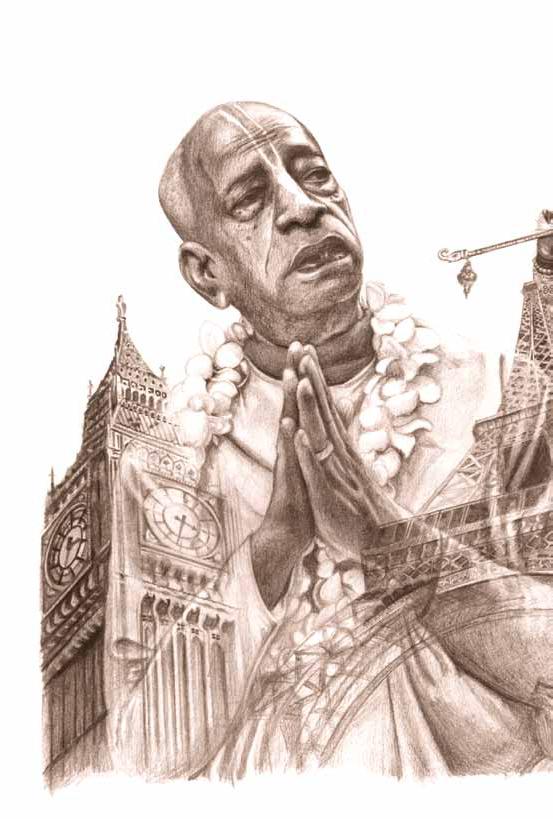

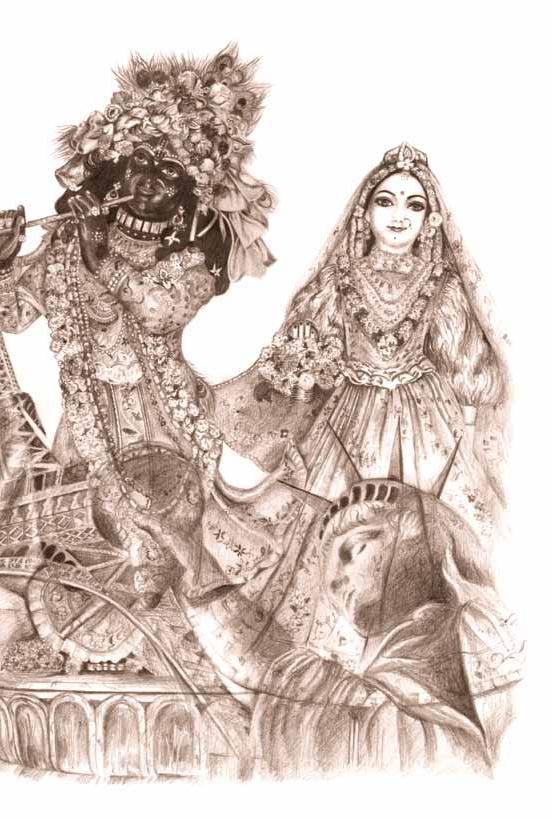
Nava-vraja-mahim§
k¥¢£a lived personally.41 The transformation that pure devotional service brings to the home of a sincere Vai¢£ava is most beautifully described by Bhaktivinoda çh§kura:
transformed into Goloka V¥nd§vana. When i take the 42
mongst ¼r¦la Prabhup§da’s many innovations is the New V¥nd§vana. The instructions that ¼r¦la Prabhup§da from two of the seven “purposes” included in iskCOn’s original articles of incorporation: “To erect for the members and for society at large a holy place of transcendental pastimes dedicated to the Personality of k¥¢£a” and “To bring the members closer together for the purpose of teaching a simpler and more natural way of life.”43 ¼r¦la Prabhup§da envisioned that these purposes could be realised in New V¥nd§vana if the devotees there concentrated their efforts New V¥nd§vana into a place of pilgrimage and an environment in which anyone could learn to love k¥¢£a. Though perhaps never pre 44

50
Introduction
provided an opportunity not only for his followers to live as k¥¢£a had the natural features of New V¥nd§vana identified with those of be a “replica of Old V¥nd§vana.” in his transcendental ambition to of New V¥nd§vana should each feature a separate temple with its own R§dh§-k¥¢£a Deities to commemorate the seven main Deities of Bhauma V¥nd§vana.45 his American followers “should have a place like V¥nd§vana.”46 Prabhup§da was also constructing a temple in Bhauma V¥nd§vana. iskCOn’s history testifies to the great pains ¼r¦la Prabhup§da endured to establish the k¥¢£a-Balar§ma temple in V¥nd§vana. it would be a place where his disciples could visit the original land of k¥¢£a and where their children could study in and naturally become k¥¢£a conscious.
And while pouring energy and resources into iskCOn ¼r¦la Prabhup§da knew that it would not be possible for all of his to encourage the global development of farming communities based on the template of New V¥nd§vana — holy dh§mas in the Western world. Devotees could be successful in their efforts to establish these Western dh§mas provided that they followed Prabhup§da’s instructions.47 The potency to invoke the dh§ma and those who sincerely followed His Divine Grace could be empowered instruments of his will.48
While other farming communities were established during ¼r¦la instead he emphasised self-sufficiency and communal living based on the principles of

51
Nava-vraja-mahim§
communities also became holy places.
The completion of the temple and the installation of R§dh§ and ¼y§masundara made 1996 a milestone year in the history of New Vraja-dh§ma. We had publicly committed to serving R§dh§ and ¼y§ma — there was no turning back. Now that the Lord had taken up us. My primary message to the devotees at the time was that a rural community based on ¼r¦la Prabhup§da’s principles of self-sufficiency was not only the best way to develop their k¥¢£a consciousness but also the best future to offer to their children. and other buildings like the school and barn. These increased facili and administrators — to name a few — all joined together in k¥¢£a Valley to
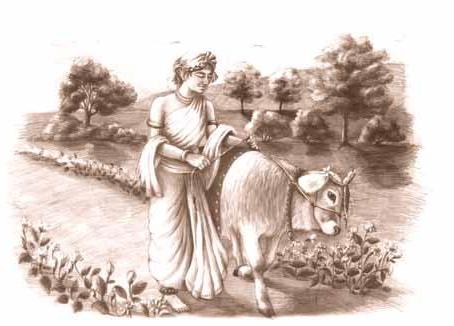
52

Introduction
realise ¼r¦la Prabhup§da’s vision for a self-sufficient k¥¢£a conscious community.49 Within ten years we had attained a level of sustainability that could see us through any emergency. Of course our way of life is still augmented by the purchase of supplementary goods and produce in order to maintain the level of comfort that recovering city-dwellers require for peace of mind while living in the country. Prabhup§da’s words: “if you go to V¥nd§vana [even] without know a nice place.”50 times our guides witnessed emotional outbursts or dramatic changes in visitors when they heard how ¼r¦la Prabhup§da had left india R§dh§-¼y§masundara’s altar and beheld the all-attractive Supreme Person and His eternal consort. k¥¢£a Valley’s popularity spread by of the fact inspired them to ask me to draw up a map of the Lord’s pastime places in New Vraja-dh§ma. A short time later they asked me to commemorate those pastime places by writing this book.

t seemed only natural — due to my familiarity with New V¥nd§vana — to follow ¼r¦la Prabhup§da’s “V¥nd§vana ome of Bhauma V¥nd§vana.51 This idea also planted the seed in me
53
Nava-vraja-mahim§
to designate as many of k¥¢£a’s pastime places as i could in pursuance of the seven purposes of iskCOn mentioned earlier. i studied His Divine Grace’s instructions on this topic and concluded that ¼r¦la Prabhup§da wanted his followers to establish holy places on his authority:
“ Because a pure he makes a holy place. it is said in the To become sanny§sa means.”52 i was in V¥nd§vana when i read these words. R§dh§-¼y§masundara write a book glorifying New Vraja-dh§ma. For an entire month i did nothing but study the concept of the dh§ma as ¼r¦la Prabhup§da and was already the chanting of the Hare k¥¢£a mantra. To make this truth even create visible landmarks for all to see. part of my vision for securing the future of k¥¢£a consciousness in Hungary. i already had a prototype in New V¥nd§vana. i had visited it many times and was acquainted with ¼r¦la Prabhup§da’s plans for it. Of utmost importance in my mind was to create a place where

54
Introduction
to their own children. i must admit that the initial components of my meditation were self-sufficiency through cow protection and agriculture and the education of our children through Direct preaching was added only after attempts to entice visitors and ¼y§masundara’s personal service that the concept of k¥¢£a Valley as a dh§ma — an epitome of V¥nd§vana and home to k¥¢£a’s many pastime places — entered my mind as a part of k¥¢£a Valley’s identity. certainly devotees had never seen New Vraja-dh§ma as different reflect that reality. of k¥¢£a Valley’s creek had created what was naturally designated Govardhana? Where is Nandagr§ma? Where is Var¢§£§?” çh§kura Bhaktivinoda says that the dh§ma sometimes becomes visible in 53 Some of us had had in helping to map out the places of Vraja on a topographical map of our property. i often wandered around k¥¢£a Valley or sat at my window overlooking the dh§ma as i chanted From those sessions i was inspired to designate specific locations on our prop a those places in a book.54 the book you now hold i finally telephoned Gaura ¼akti to discuss my plan to beautify k¥¢£a His enthusiastic response added to the encouragement i was already feeling. Having committed myself to the many delicate tasks now

55
Nava-vraja-mahim§
and my insignificant efforts would bear fruit. i had just learned a wonderful verse that helped me to remember that by taking shelter even a fledgling devotee like myself could achieve lofty goals. i put that verse into my own words to help me focus my desire:
“O my thoughts and desires! Please reject all other aspirations and just worship this abode of V¥nd§vana. Even if you cannot now shade of the tree of my spiritual desires that has sprouted up in the form of this book.”55
n mapping Bhauma V¥nd§vana onto a geographic area such arise how the pastime places in the dh§ma are assigned to The way in which ¼r¦la Prabhup§da selected a location to be the dh§ma, completely arbitrary. When his disciples acquired a plot of land in the named it “New V¥nd§vana.” And when his disciples told him about 56 Which hill Bahul§vana? ¼r¦la Prabhup§da left that to his disciples. it was classic

56
Introduction
the needful.” The spiritualisation of New V¥nd§vana — including the appearance of k¥¢£a’s pastime places — would be achieved by assigned in a way that was convenient to devotees and dictated by topography and other natural features.
While mapping Bhauma V¥nd§vana’s most prominent pastime the in New Vraja-dh§ma and Nandagr§ma in Bhauma V¥nd§vana are both to the north end of their respective geographical locations. meanders through New Vraja-dh§ma was naturally designated as
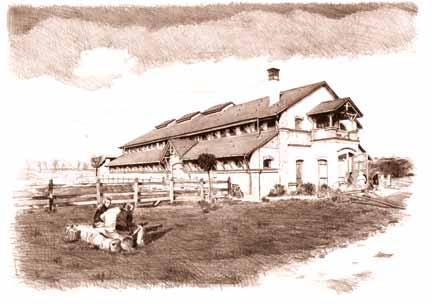

57
Nava-vraja-mahim§
the river Yamun§. But it flows through the western portion of New
This raises other obvious questions: How important is it that the locations of the holy places in New Vraja-dh§ma correspond geographically with the locations of or physically resemble those same places in Bhauma V¥nd§vana? New Vraja-dh§ma is not intended to be a facsimile of Bhauma V¥nd§vana. How could it be? it is also important to note that neither New Vraja-dh§ma nor Bhauma V¥nd§vana duplicate the dh§ma on the physical plane. locations as counterparts to k¥¢£a’s pastime places in Bhauma beautify those places in such a way that they will help us to meditate on k¥¢£a and thus increase our perception of the and its influence. The fact that those places do not physically resemble the pastime places to which they correspond — either in Bhauma or Goloka V¥nd§vana — is immaterial. The underlying influence of the is the important factor.
That is because the laws that we as conditioned souls see work unmanifest dh§ma or the ways in which it appears in this world.57 dh§ma can appear anywhere. The dh§ma can also appear through a variety of physical forms. in much the same way that k¥¢£a can assume the dh§ma can also assume any form. Thus an eternal pastime place like the Yamun§ can manifest its presence in any location regardless of physical dimen direction it flows.58
Mundane physical characteristics are ultimately irrelevant in

58
Introduction
mapping the dh§ma; hearing His glories induces the dh§ma and its attendant pastime
The essential principle of pure devotional service is that only unflinching devotion attracts k¥¢£a.59 in assigning pastime places to to do so out of devotion to ¼r¦la Prabhup§da and R§dh§-¼y§ma. And that desire is best conveyed through As ¼r¦la you are a pure devotee and you are chanting Hare k¥¢£a mantra without any offence.”60 myself a pure devotee. ¼r¦la Prabhup§da is the pure devotee whose potency has brought about the genesis of New Vraja-dh§ma. it is only on his order that i endeavour alongside the residents of k¥¢£a Valley to reveal the dh§ma in Hungary. ¼r¦la Prabhup§da clearly tells us that “strictly following” the Lord’s instructions neutralises material sciousness movement directly receives instructions from the Supreme Personality of Godhead via persons who are strictly following His naturally liberated from the contamination of the material nature.”61
Sincere dedication to the instructions of the pure devotee is devotees sometimes perform elaborate rituals in the process of install gurated the k¥¢£a-Balar§ma temple in V¥nd§vana.62 rifice and chant appropriate mantras to instal the sacred Such important at the installation of the Deities at the k¥¢£a-Balar§ma

59
Nava-vraja-mahim§
consecrate the holy places in New V¥nd§vana. But he did encourage
“i am not in Vaiku£±ha nor in the hearts of the yog¦s. i remain where My devotees engage in glorifying My activities.”63
Here k¥¢£a personally tells us that He prefers as taught by Lord caitanya makes any place more attractive to the Lord than His own opulent abode in the spiritual sky. And although Vaiku£±ha abounds in ritualistic worship performed at the highest sincere devotees continuously chant His name?

had spent considerable time in Bhauma V¥nd§vana and visited many of its most prominent places. But i had not i therefore procured an assortment of maps of Bhauma V¥nd§vana
60
Introduction
Bhauma V¥nd§vana’s major holy places on that map of New Vrajadh§ma. With faith in the principle that wherever R§dh§ and ¼y§ma approach ¼r¦la Prabhup§da had used in selecting pastimes places our would be successful. i am convinced that ¼r¦la Prabhup§da and cies of the Lord’s pastime places in the have begun to manifest their divine influence throughout the of New Vraja-dh§ma. development of New Vraja-dh§ma began. With the financial back from the dream i once had wherein both sides of our Yamun§ were opulent with dh§ma shone with divine splendour.
As i began to write or lakes. i saw how the devotees’ appreciation for k¥¢£a Valley grew we all could perceive how the dh§ma was making its presence increasingly felt. in accordance with ¼r¦la Prabhup§da’s standing order to create places

61
Nava-vraja-mahim§
dh§ma was clearly manifesting its presence in k¥¢£a Valley. By beautifying Valley to enter deeper into k¥¢£a consciousness.
Most of the devotees living in k¥¢£a Valley had previously been Prabhup§da’s mission was synonymous with preaching. For these rea as much for the devotees’ benefit as for the benefit of the visitors. The steady stream of guests gave the devotees a unique opportunity guests the practical benefits of the k¥¢£a conscious way of life. This they were still making others k¥¢£a conscious.
There is another benefit to living in the rural — not to mention transcendental — atmosphere of the it makes it easier to practise k¥¢£a consciousness. Devotees who take shelter of V¥nd§vana brighter.64 ness in V¥nd§vana is the best means of being liberated from material k¥¢£a.”65 66
As for the devotees who do not live in New Vraja-dh§ma — who choose to live in nearby Somogyvámos or to have a weekend cot And the other devotees in Hungary can regularly visit and serve in New

62
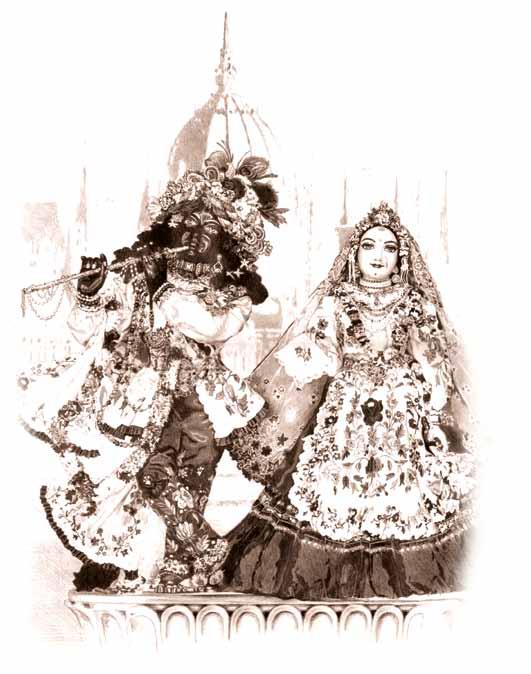

63
Nava-vraja-mahim§
move to the dh§ma, for going back to Godhead. This was also part of ¼r¦la Prabhup§da’s can constantly think of R§dh§ and ¼y§masundara and thus live in New Vraja-dh§ma within their minds.
My hope is that New Vraja-dh§ma will continue to develop for develop the pastime places of New Vraja-dh§ma. k¥¢£a personally assures His devotees that by constructing a temple for the Deity or k¥¢£a’s own.67 those who serve R§dh§-¼y§masundara and Their sincere servants very own property. it is my personal meditation to serve Them life time of S§k¢i-gop§la.68 themselves as ordinary people to render service to the Deity. But whether devotees are long-standing servants of the Deity or new recruits in ¼r¦la Prabhup§da’s to live in or just to visit the abode of R§dh§ and ¼y§masundara. barriers of matter are the most fortunate. With eyes anointed by times in the groves of New Vraja-dh§ma. it is just a matter of k¥¢£a consciousness.
How do R§dh§ and ¼y§ma enjoy pastimes in New Vraja-dh§ma while at the same time They remain standing on the altar? By Their inconceivable potency. in forms the divine couple eternally Deity forms They give to those fortunate enough to have visited Their temple.

64
Introduction
gop§la and Madana-gop§la left Theirs.69 Nothing is impossible for the Supreme Lord.
New Vraja-dh§ma opened its gates to the world in order to draw the Supreme Person. Faithless or materially conditioned souls may appearance in k¥¢£a Valley marked the advent of Hungary’s supreme monarchs and its spiritual capital. Thousands already visit Their Lordships each month to gain inspiration from k¥¢£a Valley’s charm and R§dh§-¼y§masundara’s beauty. i have hope that one day the even His guidance. The Supreme Personality of Godhead is the owner and enjoyer of everything. Without His blessings there is hope for neither material nor spiritual prosperity. Everyone must bow to Him. i conclude with words i have adapted from one of ¼r¦la towards R§dh§-¼y§masundara and New Vraja-dh§ma: motherland is fulfilled by loving New Vraja-dh§ma.”70

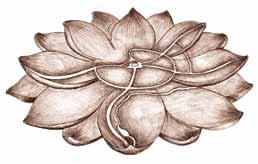
65
Notes
1. 2.4.18. 2. This artefact was given to the Hungarian Archaeological Society. They determined that it was more than eight hundred years old. 3. Gaura ¼akti D§sa was at that time the president of the Budapest temple. 4. 5. 6. “R§dh§ and ¼y§masundara” — is my humble attempt to appreciate but a few of Their unlimited glories. 7. thing. While ¼r¦la Prabhup§da did indeed use this word to refer to at least two of the dh§mas he established — New V¥nd§vana not seek to physically replicate Bhauma V¥nd§vana. How could it? V¥nd§vana — the — by creating the true atmosphere of V¥nd§vana. Thus i have chosen the word “epitome” instead of “replica” to more clearly voice what we are trying to do at New Vraja even “soul” all bear some connection with what it means to epitomise something. And all of these terms more successfully convey the idea of what New Vraja-dh§ma is meant to be in relation to Bhauma

66
Notes
“the dh§ma,” but the true essence of the V¥nd§vana atmosphere is 8. in his ( in contrast to the forms of the ¼§lagr§ma — which are considered dh§ma — the Deity forms of the Lord are forms are identical in appearance. 9. pounded solid in between steel moulds. 10. New Gokula is the name ¼r¦la Prabhup§da gave to what is more called R§dh§-Gokul§nanda. 11. 3.15.39. 12. 13. V¥nd§vana renovated: “¼r¦ caitanya Mah§prabhu personally reno the general populace.” ( 14. ¼r¦la Prabhup§da frequently uses the analogy of the “iron rod in fire” to describe the process by which matter becomes “spiritualised”: “When the material energy is engaged in the service of the Supreme fire.” ( 15. see the section entitled “The Truths of the Dh§ma” that immediately follows this introduction. 16. 1.67. 17. 1.3.32–33. 18. “Regarding Mural¦-manohara i understand that the Patels

67
Introduction
are ready to present silver but we cannot worship Mural¦ consort R§dh§r§£¦. You know that we worship R§dh§’s k¥¢£a. We should always understand that k¥¢£a is sold to the loving service 19. 107. 20. 21. 1.1.1. 22. 23. ¼r¦la Prabhup§da also says that “the place where ¼r¦ R¡pa Gosv§m¦ and San§tana Gosv§m¦ formerly lived has now become a place of pilgrimage.” 24. 25. 26. centre.” 27. and interesting details of Vi¢£upura’s subsequent history and development as a place of pilgrimage were gleaned from an article by Pike Gosh entitled . Another reference that helped in compiling the picture of Vi¢£upura’s development was by Steven Rosen. 28. 7.476. 29. page 202. 30. Bandha, or lake. 31. page 212. 32. 33. as cited in page 26. 34.

68
Notes
35. 36. 37. ( that by His inconceivable powers k¥¢£a appears directly in His Deity Here the word “directly” ( the ( spiritual.” 38. 10.1.28: “The city and district of Mathur§ eternally.” 39. This is intended to mean that V¥nd§vana is present in the homes of devotees where the Deity of k¥¢£a is worshipped with love. it is not affiliated with iskCOn with requisite devotion. 40. 41. k¥¢£a ( Lord. it is mentioned here that the Lord identified the house with His ( 42. 43. 44. an online magazine of the New V¥nd§vana com

69
Introduction
compiled by caitanya Ma¯gala D§sa. Because this article so clearly summarises ¼r¦la Prabhup§da’s vision for New V¥nd§vana and therefore the model for New Vraja-dh§ma and its
1. cow Protection: tion to the cows and that should be the main business of New
“Therefore the special feature of New V¥nd§vana will be maintain as many cows as possible in your New V¥nd§vana.” 2. Sustainable Agriculture:
“The whole idea of New V¥nd§vana is that men who are 3. Simple Village Life:
“ means that we should simply accept the for spiritual advancement. This should be the motto of New
“it may be an ideal village where the residents will have plain

70
Notes
“New V¥nd§vana does not require to be modernized because k¥¢£a’s V¥nd§vana is transcendental village.” (Letter
“Go on acquiring the surrounding lands and in this way we will establish a local self-governing village and show all the 4. A Place of Pilgrimage in the West:
“New V¥nd§vana should be taken up very seriously because actually i want to develop a replica of Old V¥nd§vana. i have got
“So you have now taken charge of the sunrise of New V¥nd§vana. Our program is there for constructing seven tem
“Now i am hopeful that our New V¥nd§vana will be an and that will give me the highest pleasure.” (Letter to 5. A Place of Higher Learning:
“One R¡p§nuga Vidy§p¦±ha — that is a school for educating
“You remark that in New V¥nd§vana the capacity is lacking

71
Introduction
for taking care of the children. if you can organize a higher
“Another important thing is our theistic school in New
“Regarding using New V¥nd§vana land for building for the older for k¥¢£a: their we want to create this atmosphere and thereby show the whole world how practical and sublime our movement is.” (Letter to

45. additional instructions indicate he had no intention of stopping there. time iskCOn could match that numerical model: “The whole modern started their own temples and thus the present V¥nd§vana is now full N§r§ya£a is attempting to get some pairs of R§dh§-k¥¢£a 24” high. We shall require so many pairs of R§dh§-k¥¢£a at differ 46. 47.
72
Notes
¼r¦la Prabhup§da’s vision for other “replicas” of the holy dh§ma in the like we have got our New V¥nd§vana. This year we have seen practi ing of the holy name was going on and hearing about was going on. There was V¥nd§vana.” (Lecture on to establish such communities as New V¥nd§vana all over the world: “At the present moment i am staying in our French castle in the village of Lucay-le-Male. We have purchased recently two hundred herewith. i am now organizing in Europe and America many farm here in France. This place is a little interior from Paris about one hun with great enthusiasm. They are chanting Hare k¥¢£a also village to a k¥¢£a consciousness community on the land which you have is very good. Whenever we get some land available we should take the opportunity to develop it into an ideal community as envisioned for New V¥nd§vana. We can have a great many such communities all

73
Introduction
happiness he is seeking. So as you say that your land is very suitable for cow protection and for and if possible provide fresh milk and butter for the temples nearby. And the rest of the time chant Hare k¥¢£a and read my books. in this way you can live very peacefully without any disturbances from 48. it is interesting to note that the history of New V¥nd§vana has had its peaks and valleys. At one point after ¼r¦la Prabhup§da’s disap iskCOn because of significant deviations later once they had again conformed to iskCOn’s spiritual standards.
After forty years one can still — in ¼r¦la Prabhup§da’s own a place of pilgrimage for devotees in the United States. The endurance the sincere efforts of devotees strictly following the teachings of ¼r¦la 49. are devotees directly engaged in the day-to-day service of the Deities. 50. Lecture on 1966. 51. ¼r¦la Prabhup§da used the phrase “V¥nd§vana scheme” in his 52. 53. page 9. 54. Were these dreams and meditations purely transcendental? i am convinced they were R§dh§’s and ¼y§ma’s way of encouraging our ardent desires to please Them. While rare devotees may be qualified

74
Notes
dreams or “visions” that serve to inspire them in their spiritual pur in the service of guru and k¥¢£a also sometimes benefit from the Lord’s mercy in this way? We should not automatically conclude that we have directly seen the Lord when we have dreams of this 55. This prayer is adapted from from 104. 56. 57. The the features of the the pastime places situated within the and the purified consciousness required to perceive the all are dh§ma ment of persons within the dh§ma events in one place within the dh§ma making themselves visible to pure devotees in another.
The following section will address the five points just raised: where it was established by Bhaktisiddh§nta Sarasvat¦ çh§kura at smallest parts — even in a speck of dust. Regarding k¥¢£a, Brahm§ “All the universes same time.” (

75
Introduction
equally to the “[k¥¢£a’s] abode is beyond human concep cit resides simultaneously in His fullness and entirety in all the atoms in all the worlds. All-pervasiveness is only a localised aspect of the Lordship beyond human conception.” Yoga-p¦±ha be?” The simple answer is wherever R§dh§ and ¼y§ma are. The change of location on the physical plane. This is a characteristic of its vision can see the same great meeting place of R§dh§ and k¥¢£a at any physical location. cal characteristics — it will look to mundane vision like an entirely Govardhana appears to be only a few metres from end to end. For other manifestation of the

76
Notes
sometimes shows little regard for natural laws. The divine laws that govern the transcendental realm are completely different from the mundane laws of this physical world. Whenever those divine laws for some reason supersede the laws of what conditioned souls call dh§ma have been known to stroll over very long distances in very short periods of time. kavir§ja Gosv§m¦ describes how ¼r¦ R§dh§ walked the forty miles from Var¢§£§ to V¥nd§vana in a few minutes. ( This is all possible by the mercy of the dh§ma; transcendentalists are dh§ma that lies beneath its earthly covering. They therefore move from one place to another under the conditions provided by apart or closer together in order to accommodate devotees and their needs in serving k¥¢£a. dh§ma also accommodates the abil another far distant location within the Once some sincere how to perform any miracles.” He then picked up a stick and beat it out a goat who was eating the plant near the cottage of ¼r¦la confirmed what B§b§j¦ Mah§r§ja had said: the previous day a goat entered the cottage of Lokan§tha Gosv§m¦ and ruined the plant there. Although Navadv¦pa and V¥nd§vana are separated by

77
Introduction
of the same his perspective only reacting to what he saw. 58. i heard a narration from local that was later confirmed
A resident of V¥nd§vana once went on pilgrimage throughout india. During a visit to Ekacakra he was told that Lord Nity§nanda’s birthplace is in no way different from V¥nd§vana. The Yamun§ River in all her majesty. His guide led him to a small stream The Vraja-v§s¦ could not believe what he was hearing. Was he really river in which he bathed daily in V¥nd§vana? And what about the places really contained within this tiny village? Was V¥nd§vana’s sented by the small agricultural field his guide had shown to him? With these doubts fresh in his mind the Vraja-v§s¦ took his bath in the little stream purported to be the Yamun§ River and he chanted in the rapidly growing darkness he was unable to retrieve it. tually returning to V¥nd§vana. Upon his arrival in Vraja he went walking stick! The Vraja-v§s¦ immediately understood his error. Lord Nity§nanda had very kindly proved to him that the Yamun§ forced to admit was in no way different from V¥nd§vana-dh§ma. 59.

78
Notes
60. Lecture on 1972. 61. 62. k¥¢£a-Balar§ma temple in his purport to 6.3.25: would not accept Europeans and Americans as bona fide Thus we had to engage to perform costly in spite of these the members of our Society performed loudly with and i considered the more were meant for persons interested in Vedic rituals for elevation to heavenly planets ( was meant for pure devotees interested in pleasing the Supreme Personality of Godhead. We would simply have performed but then the inhabitants of V¥nd§vana would not have taken the installation ceremony seriously.” 63. as quoted in 64. This statement is adapted from purport. 65. 66. ( should live in the dh§ma? ¼r¦la Prabhup§da elaborates: “An advanced devotee like N§rada Muni who is engaged in preaching work can serve the Supreme Lord anywhere.” Devotees who are actively preaching or who are spiritually advanced can live anywhere. But if a devotee’s time and energy is consumed by the obligations of family

79
Introduction
devoted to maintaining a high standard of devotional practice and to keeping good devotee association. 67. 11.27.51–53. 68. ‘You two are of the Lord and His servant may be eternally connected. in his His devotee do indeed share an eternal relationship: “Like these two eternal servants of the Lord. They are specifically known as siddha, eternally perfect. Although the appear in the never forget the Supreme Personality of Godhead in any condi that they are His servants birth after birth. The phrase ‘birth after birth’ refers to remains within this material world is to broadcast the glories of the Lord.” ( 69. The pastime in which Madana-gop§la left His altar is told in chapter 21 of this work. 70.

80


